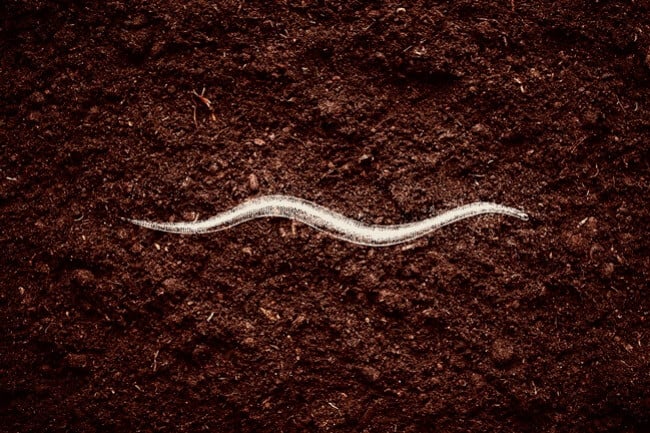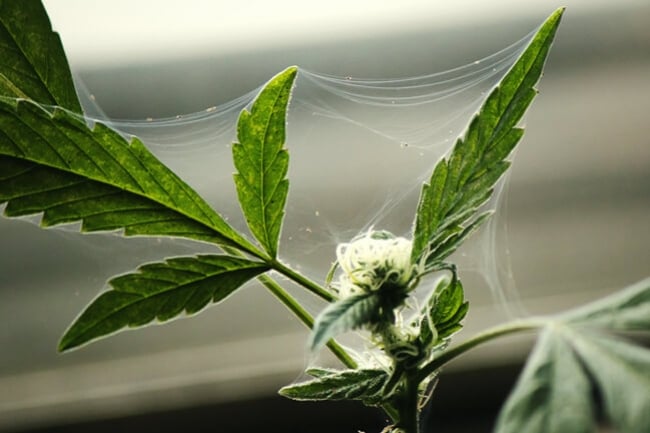.

Cannabis Pests: How to Deal With Slugs and Snails
Slugs and snails play a beneficial role in garden ecosystems. However, as their populations rise, they can inflict significant damage on cannabis plants and even consume entire seedlings. To increase your odds of a successful harvest, learn how to defend your crop from these hungry critters, and prevent them altogether.
When growing cannabis outdoors for the first time, it doesn’t take long for reality to set in. Though idealistic visions of Shire-like aesthetics, huge energy savings, and the tranquillity of being one with nature may inspire you to start sowing seeds, you’ll ultimately have to contend with a variety of adversaries—both microscopic and visible to the naked eye—that see your cannabis plants as nothing more than their next meal. Among these prowling foes, slugs and snails rank as two of the most damaging. When left to roam of their own accord, these slimy critters make quick work of cannabis leaves.
So, what can you do about this problem? Below, you’ll learn exactly how slugs and snails affect cannabis plants, how to combat them when they appear, and how to prevent them from inflicting damage in the first place.
Contents:
- How do slugs and snails affect cannabis plants?
- Signs of slug and snail damage on cannabis plants
- How to get rid of slugs and snails on cannabis plants
- How to deter slugs and snails on cannabis plants
- Good luck, soldier
- How to deter large insects
- Shield your weed from small insects
- Keep your crop safe from hungry animals
How Do Slugs and Snails Affect Cannabis Plants?
Do slugs eat weed plants? Yes. Do snails eat weed plants? You bet they do! Slugs and snails are gastropods that, alongside ocean-dwelling limpets and abalones, belong to the class Gastropoda. The word “gastropod” derives from Greek and means “stomach foot”—a term that describes the large muscular foot that runs along the underside of both slugs and snails.
Although they lack legs, these creatures are surprisingly mobile; snails can travel up to 200m in a single day. Snails and slugs also lack the large mouths of herbivorous mammals, but this doesn’t stop them from inflicting serious damage on cannabis foliage. Both of these life forms feature jaws and bands of thousands of microscopic teeth. Using a rasping motion, they’re able to cut off leaf particles to feed.
Are Slugs and Snails the Same?
Although they share similarities, several key differences separate slugs and snails. Most noticeably, snails lug around a coiled calcium carbonate shell on their backs—a form of evolutionary armour that provides defence against predators. Slugs, on the other hand, lack a hard exterior shell. Overall, snail species grow larger than slugs. The former can reach up to 25cm in length, whereas the latter max out at 15cm. Despite their shell, snails also move faster than slugs—at a pace of around one millimetre per second. Beyond these differences, both of these creatures primarily dine on vegetative tissue—including cannabis leaves.

Signs of Slug and Snail Damage on Cannabis Plants
You won’t have a hard time identifying slug and snail damage in the garden. The key signs to look for include:
| Irregular, ragged holes on leaves | Scalloped edges on the side of leaves |
| Slime trails on leaves and nearby soil | The complete disappearance of young plants |
Slugs and snails can strike at any point during the growing season, and are more likely to attack if you unintentionally provide them with an attractive environment. However, older plants are more likely to survive an attack, despite a few holes in their foliage. Slugs and snails commit the most damage earlier on in the season, during spring, and have the capacity to devour entire seedlings.
How to Get Rid of Slugs and Snails on Cannabis Plants
So, if you do happen to see holes and slime trails all over your cannabis leaves, how can you go about keeping slugs and snails off your plants? Thankfully, slugs and snails are easier to tackle than more abundant and persistent pests, such as aphids and mites. Some solutions are as easy as picking them up and relocating them, whereas others involve introducing other life forms into the garden to consume these grazing gastropods. In what follows, we run through the top options to stop a slug or snail attack.
Remove Them Manually |
Remove Them Manually |
Because slugs and snails are relatively large, many growers successfully defend their crops by hunting these critters down, picking them up, and moving them elsewhere. However, you’ll need to time things right for this method to be effective. Snails and slugs aren’t big fans of the heat and light of day. For this reason, they choose to emerge from slumber and look for food during the night and early morning hours. If you’re hoping to hunt them down, do so armed with a torch just before bed or as soon as you wake up in the morning. During the day, you can also preemptively target slugs and snails by lifting up pots, bricks, and any other nearby sheltered locations where they’ll likely be hiding.
Attract Natural Predators |
Attract Natural Predators |
If you have a slug or snail problem and don’t have the time to chase them around every day, then you can rely on nature to get the job done. By creating an environment attractive to natural predators, you’ll see your snail and slug population begin to drop sharply.
Dig a small pond to win the residence of toads and frogs; apply mulch to your garden beds to serve as a habitat for ground beetles; put up bird feeders to bring in the aerial anti-slug division. Moreover, if you have lots of dense undergrowth and a variety of lengths of grass in your garden, this will attract hedgehogs, which love to feed on slugs and snails. Another ally against them are slow worms, which are attracted by warm and sheltered spots, such as compost heaps, logs, and rock piles.
Use Traps to Catch and Release |
Use Traps to Catch and Release |
If you don’t have the time or energy to walk around finding slugs and snails, you can make them come to you, and then trap them. Live traps are the most humane and sidestep the need to use pesticides or poisons. You can then release the critters somewhere far away from your garden.
Another, slightly more aggressive method is to rely on a substance that also attracts humans: beer. Insert a plastic cup into the soil near your plants so that the lip of the cup sits just above the soil surface. Fill the container half full with beer. Slugs and snails can’t resist the aroma; they’ll autumn in and meet a tipsy demise. The only problem with this method? Other life forms, including those beneficial for your garden, will also autumn in and meet the same fate, so only use beer traps if you really need to.
Consider Nematodes |
Consider Nematodes |
Nematodes are microscopic worms that play a fundamental role in the soil food web. There are several types of nematodes; some eat fungi, others bacteria, some chomp plant roots, and others target slugs. Some species of nematodes live as parasites inside slugs and work as an effective biological control for this pest. There are plenty of nematode products available that involve simply watering them into the soil.
How to Deter Slugs and Snails on Cannabis Plants
You don’t have to wait to discover damage to your cannabis plants to start taking measures against slugs and snails. As the old saying goes, prevention is better than cure. Putting physical barriers in place and growing beneficial plants nearby can help to fend off slugs and snails before they sink their microscopic teeth into your marijuana plants. Discover these strategies in more detail below.
Build Copper Barriers |
Build Copper Barriers |
Slugs and snails really don’t get on well with certain materials, including copper. Upon contact with this element, these creatures experience something similar to an electric shock. If you’re growing directly in the ground, consider creating a perimeter of copper mesh or wire around the base of your cannabis plants. If you’re growing in containers or raised beds, you can purchase copper sticky tape and apply it to the rim of your beds or containers to serve as a protective shield. How effective this method is, however, is debatable.
Cover Soil With Eggshells and
|
Cover Soil With Eggshells and Diatomaceous Earth |
Eggshells and diatomaceous earth also help to repel slug and snail attacks. These sharp materials irritate their soft underbellies and force them to go and find a snack elsewhere. Eggshells are the most easily accessible. After cooking up an omelette, set aside the shells, crush them into a coarse powder, and sprinkle them around your plants. Diatomaceous earth—the silicon skeletons of a type of algae—has a similar effect.
Add Companion Plants to Your
|
Add Companion Plants to Your Cannabis Garden |
As their name suggests, companion plants serve to protect cannabis from a wide array of adversaries, including slugs and snails. You can look at companion plants as “sacrificial plants”—species that rank higher on the menu of desirable dinners for slugs and snails. Planting basil, lettuce, spinach, and cabbage close to your plants will divert hungry critters. Not only will these plants take the bullet, but they’ll alert you to the presence of slugs and snails before they work their way over to your weed plants.
Good Luck, Soldier
You’re now equipped with several strategies to deal with slugs and snails on cannabis plants, and to prevent them from making contact in the first place. Now, step forth onto the battlefield of your garden, safe in the knowledge that you can protect your weed plants from one of their most damaging predators.



























































